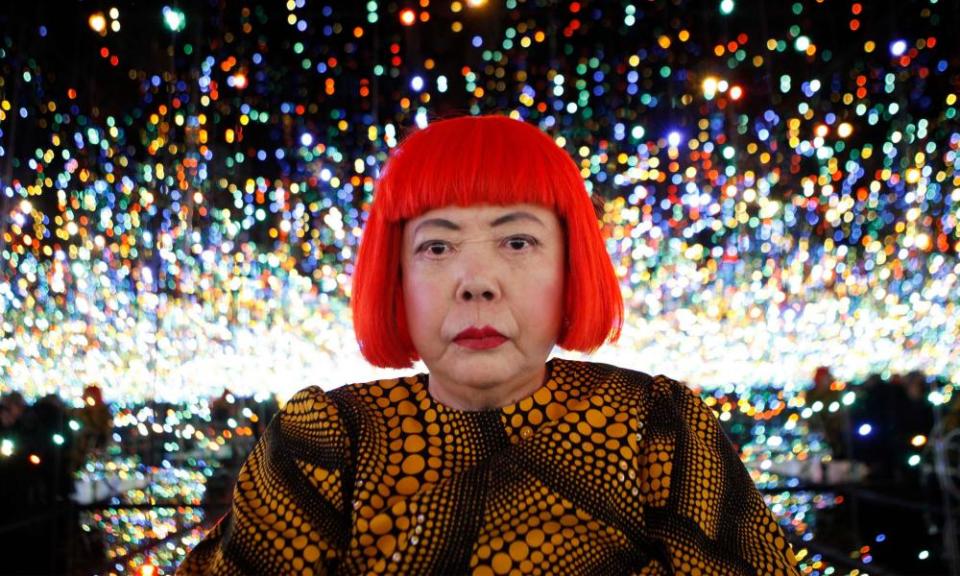‘My cheapo garden fairy lights do this too’ – Yayoi Kusama: Infinity Mirror Rooms
All done with lights and looking glasses, Yayoi Kusama’s year-long display of Infinity Mirror Rooms is already booked-out until late October. Viewers must queue and wait, at £10 a head, for two, two-minute dives into Kusama’s universe. Hardly enough time to get your bearings, let alone lose them, which seems to be the point of her disorientating halls of mirrors.
Tate Modern says it is being relatively generous about how long viewers may spend in the artist’s installations: at some venues, visitors get only 30 seconds to adjust to her glimmering darkened spaces. Then you’re out, matey, ready or not, wowed or otherwise. Time for a selfie though, if that’s your thing. And for many, I fear, it is. Although such installations are perceptually complex and disorientating, their spectacular effects are all too readily assimilable to Instagram. This really is a bit absurd. Many people are hungry, I suppose, for some kind of transformative, mystical or even transcendental experience, and one that requires neither fasting nor drugs, let alone months or years of mental and physical preparation. Inner visions, like dreams, are no good as selfie opportunities. They’re all in your head.
Kusama’s art is driven by her inner experiences, reporting back on things only the mind can see. Beset by visual hallucinations, Kusama has for almost the entirety of her long life been prey to proliferating and insistent visual disturbances. She has found ways to accommodate her fixations and subjective perceptions of unseen forces into her work, using it as source, material and energy.
Walking into her Chandelier of Grief, I never quite lose my sense of planes, edges and boundaries, the black carpet under my feet, the hexagonal chamber containing a slowly revolving crystal chandelier, its lights flaring and dimming, the crystals throwing fleeting little rainbows of colour here and there. The multiple mirrored reflections seemingly revolving alternately clockwise and anticlockwise, flattening out along the horizontal plane and simultaneously plunging below us and soaring ever upward over our heads. It is as if we were in a clockwork universe of endlessly proliferating, rotating gears, a Keplerian machine of cycles and epicycles which has no end, all of which sounds a great deal more engaging than I actually found it.
In her larger, the walk-through Infinity Mirrored Room – Filled with the Brilliance of Life, little hanging lights glow and dim as they cycle through their programmed sequence of colour changes. My cheapo garden fairy lights do that too, even when I don’t want them to. As well as mirrors and a walkway, reflecting pools of water redouble the confusion. The mechanics of Kusama’s looking-glass theatres snag me, but not in particularly interesting ways. The staging of her lights and mirrors remind me less of star-fields or pinging neurons and networks of firing synapses, as of airports or refineries at night, or of being E-ed up and bathing in a disco glow, or being caught in a silent killing field of computer-game tracer fire and sci-fi force fields. None of which I plan to do any time soon. Beam me up and get me out of here before I faint from the excitement of it all.
Kusama’s Infinity Mirror Rooms just don’t do it for me. I appear to be immune to them. Maybe I’d appreciate them more if I visited with a small child, and could share in their easy wonderment, except I’d worry they might drown in one of those shallow pools. Maybe a drawn-out expectation of the moment, the booking, the waiting for the day and the minute, all that queuing, might help develop a sense of occasion.

Kusama’s light installations are the main event here, and are augmented by series of portrait photographs of the artist, taken over her long career, as well as pictures of performances, which are both sexy and silly, earnest and ridiculous. In a recently rediscovered short film by British academic John Jones, we see a young Kusama walking in red thigh-length boots about her studio, posing behind a stepladder festooned with little sculptures and high-heeled shoes, and lying naked from the waist down in a nest of white phallic sculptures, kapok-stuffed white gloves and other floppy forms.
As much her work looks back to surrealism, the film, shot in the mid-1960s, has both a touching innocence and an oddly prurient feel that some might take as period charm. How long you can linger to see all this, and the box-like recent sculpture whose peepholes afford colourful views of globular little dots, before the next punters are shepherded through, I cannot say.
• Yayoi Kusama: Infinity Mirror Rooms is at Tate Modern, London, 18 May to 12 June 2022.

 Yahoo Movies
Yahoo Movies 
